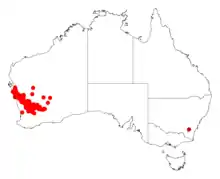Acacia stereophylla
Acacia stereophylla is a tree or shrub belonging to the genus Acacia and the subgenus Juliflorae that is endemic to south western Australia.
| Acacia stereophylla | |
|---|---|
| Scientific classification | |
| Kingdom: | Plantae |
| Clade: | Tracheophytes |
| Clade: | Angiosperms |
| Clade: | Eudicots |
| Clade: | Rosids |
| Order: | Fabales |
| Family: | Fabaceae |
| Clade: | Mimosoideae |
| Genus: | Acacia |
| Species: | A. stereophylla |
| Binomial name | |
| Acacia stereophylla | |
 | |
| Occurrence data from AVH | |
Description
The tree or shrub typically grows to a height of 1 to 6 metres (3 to 20 ft).[1] It has glabrous branchlets that are hairy in the axils. Like most species of Acacia it has phyllodes rather than true leaves. The evergreen phyllodes are ascending to erect with a straight to shallowly incurved shape. They have a length of 10 to 18 cm (3.9 to 7.1 in) and a width of 1.3 to 6.5 mm (0.051 to 0.256 in) and have many closely parallel fine nerves.[2] It blooms from June or August to October producing yellow flowers.[1]
Taxonomy
There are two varieties:
- Acacia stereophylla var. cylindrata
- Acacia stereophylla var. stereophylla
Distribution
It is native to a large area in the Mid West and Wheatbelt region of Western Australia.[1] The bulk of the population of found from around Kalbarri National Park in the north west down to around Tammin in the south east and to around Boorabbin in the east.
See also
References
- "Acacia stereophylla". FloraBase. Western Australian Government Department of Parks and Wildlife.
- "Acacia stereophylla". WorldWideWattle. Western Australian Herbarium. Retrieved 12 March 2020.